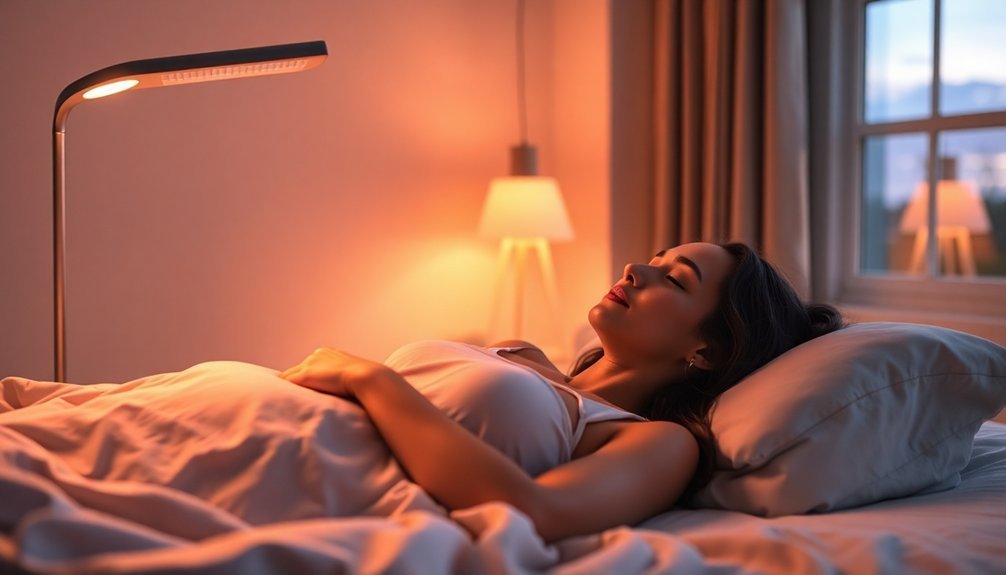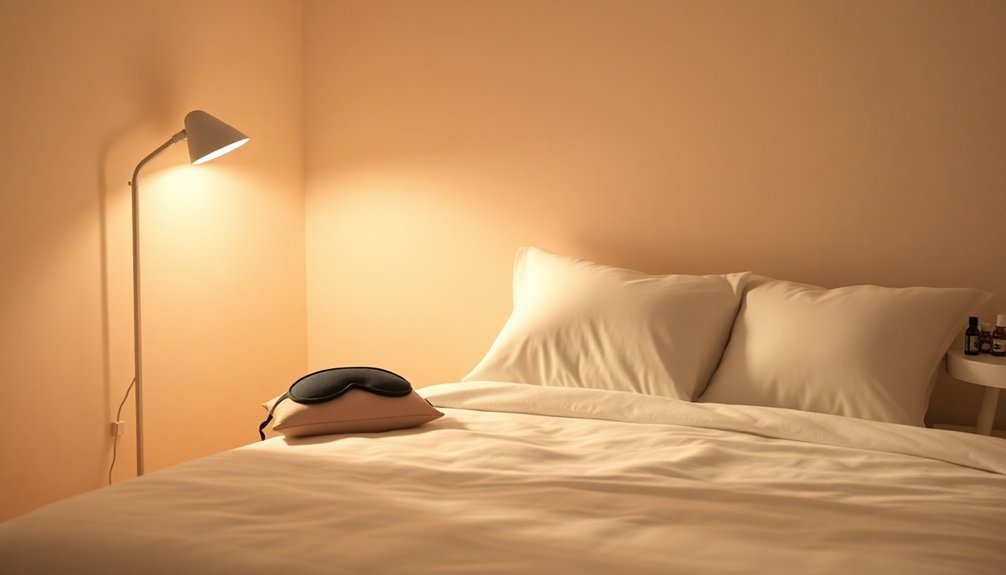Infrared treatment can effectively reset your sleep pattern in three key ways. First, it helps regulate your circadian rhythms by influencing your body temperature, which eases you into sleep. Second, it enhances melatonin production, allowing your body to naturally align itself with evening cycles for better rest. Finally, it reduces sleep disorders by alleviating symptoms of insomnia and lowering sleep latency, so you wake up feeling refreshed. You'll discover how to maximize these benefits and improve your sleep quality even further as you explore the details and insights just ahead.
Regulating Circadian Rhythms

Regulating your circadian rhythms is vital for quality sleep, and infrared treatment plays a key role. Infrared light helps influence your body temperature, which is instrumental for falling asleep. As you drift off, your body temperature naturally drops; however, cold winter nights can disrupt this process. By using infrared light, you can boost your circulation and warm your body, creating an environment that's conducive to sleep.
Moreover, infrared therapy reduces muscle tension and stress, both of which can hinder your ability to relax. The added holiday pressures typical in fall and winter often amplify stress, but relieving that tension makes it easier for you to achieve restorative sleep. Additionally, this therapy stimulates serotonin and endorphin production, combating seasonal mood dips that can further disrupt sleep.
In addition to warming your body and easing stress, infrared light improves circulation and tissue health. This enhanced blood flow guarantees your body repairs and regenerates while you sleep, leading to rejuvenating rest.
As infrared light acts as a zeitgeber, it nudges your internal clock to align more closely with natural external cues. With consistent use, you can maintain a balanced sleep-wake cycle, assuring you wake up feeling refreshed and ready to face the day.
Enhancing Melatonin Production
When it comes to achieving quality sleep, enhancing melatonin production can greatly contribute to your success. Red and near-infrared light therapy works at the cellular level, stimulating functions in your mitochondria rather than directly activating your pineal gland. This therapy promotes the activity of enzymes like cytochrome C oxidase, which supports melatonin production. Research indicates that red light therapy can enhance melatonin production, improving overall health and sleep quality. Studies show that red light therapy can considerably boost your serum melatonin levels. For instance, one study demonstrated an increase from 22.2 pg/mL to 38.8 pg/mL after treatment. The therapy's effectiveness grows when used in the evening, aligning with your body's natural melatonin production cycle.
Natural sources, like sunlight and the infrared emissions from campfires, can also trigger melatonin production. It's crucial to limit exposure to artificial light, especially blue light from screens, as it suppresses melatonin levels.
To maximize the benefits of red light therapy, use professional-grade devices that emit light at 660-850 nanometers in your evening routine. Combining this practice with good sleep hygiene can further enhance your melatonin levels, ultimately improving your sleep quality.
Reducing Sleep Disorders

Reducing sleep disorders can be considerably aided by the application of near-infrared light therapy, especially when used before bedtime. This treatment effectively decreases sleep latency by about six minutes and enhances the overall quality of your sleep. Users of near-infrared light-emitting devices often report feeling more refreshed in the morning compared to those using placebo devices.
If you're struggling with insomnia, near-infrared light therapy can help alleviate its symptoms. While statistical differences in insomnia severity scores may not be stark, self-reported improvements in sleep-related symptoms are common among those utilizing this therapy. Better sleep and relaxation are essential for managing insomnia, and users consistently note these benefits. Additionally, exposure to bright light in the morning can help improve your overall alertness and mood, further supporting sleep management.
Moreover, you may notice improved daytime function and relaxation as a result of this therapy. Participants using the light-emitting collar often experience increased energy levels and perceived relaxation throughout the day.
The practical aspect of wearing a cervical collar during treatment makes it a user-friendly option. While further research is needed to optimize treatment parameters, the existing findings suggest near-infrared light therapy is a promising method for reducing sleep disorders and enhancing overall well-being.
Frequently Asked Questions
How Long Should I Use Infrared Therapy for Effective Results?
You should use infrared therapy for about 10 to 20 minutes per session. This duration allows your body to absorb the beneficial wavelengths effectively without overstimulation, promoting relaxation and preparing your mind for restful sleep.
Can I Use This Therapy While Pregnant?
You can generally use this therapy while pregnant, but it's essential to consult your healthcare provider first. They'll help guarantee it's safe based on your unique situation and manage any potential risks or discomforts.
Are There Any Age Restrictions for Using Infrared Light Therapy?
There aren't strict age restrictions for infrared light therapy, but you should exercise caution with children and the elderly, especially those with health issues. Always consult a doctor if you have underlying health concerns.
Is Infrared Light Therapy Suitable for Children?
Yes, infrared light therapy can be suitable for children when used correctly. Just verify you're using FDA-approved devices, limiting session times, and monitoring for any skin irritation. Always consult a healthcare provider beforehand.
How Does Infrared Therapy Differ From Other Sleep Treatments?
Infrared therapy differs from other sleep treatments by being non-invasive, safe, and easy to incorporate into your routine. Unlike medications or bright light therapy, it gently promotes natural sleep cycles without causing side effects or disruptions.
In Summary
By incorporating infrared treatment into your routine, you can effectively reset your sleep pattern. You'll notice improvements in your circadian rhythms, enhanced melatonin production, and a reduction in sleep disorders. This holistic approach not only promotes deeper, more restorative sleep but also helps you feel more energized and focused during the day. If you're struggling with sleep issues, consider giving infrared therapy a try to reclaim your nights and boost your overall well-being.





Leave a Reply